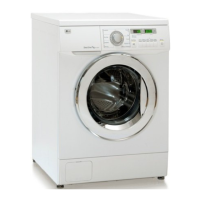
Do you have a question about the LG WD-16330FD and is the answer not in the manual?
LG's jumbo drum increases wash load capacity for better performance.
Optimizes water usage and wash time based on load and temperature.
Prevents children from altering the program during operation.
Minimizes spinning noise by sensing load balance.
Resumes the wash cycle automatically after a power failure.
Features a Brushless DC motor directly driving the drum without belts.
Detects water leaks to prevent flooding, ensuring floor safety.
Enhances soaking and rinsing efficiency by recirculating water and detergent.
Essential precautions to prevent fire, electric shock, injury, or property damage.
Proper grounding procedures to minimize the risk of electric shock.
Identifies the appliance as a front loading washing machine.
Details the required electrical input: 220-240 V~, 50 Hz.
Provides the physical dimensions of the washer: 600mm(W) x 600mm(D) x 850mm(H).
Specifies the appliance weight as 65 kg and maximum power as 2100 W.
Indicates the maximum laundry load capacity is 7 kg.
Shows water usage: 49 liters total, or 7 liters per kg of laundry.
States the acceptable water pressure range: 0.3-10 kgf/cm².
Lists available spin speeds for various programs and models.
Lists included items such as the inlet hose and spanner.
Appliance is equipped with transit bolts to prevent damage during transport.
Step-by-step instructions for safely removing transit bolts.
Guidelines for selecting a suitable installation location and ensuring proper clearance.
Instructions for placing the washer on a stable, level floor for adequate air circulation.
Procedures for safe electrical hookup, avoiding unauthorized adapters.
Instructions for properly connecting the water inlet hose to the supply.
Steps for attaching the inlet hose to a screw-type tap.
Steps for attaching the inlet hose to a one-touch tap.
Guidelines for correct drain hose placement to prevent water leakage and noise.
How to adjust the machine's feet for stability and to prevent noise/vibration.
Specific installation advice for concrete flooring surfaces.
Recommendations for installing on tile floors, including anti-slip measures.
Guidance for wooden floors, suggesting vibration dampening solutions.
Initial cleaning cycle to prepare the machine for use.
Advice on checking garment care labels for proper washing.
How to sort laundry by color, soil level, and fabric type for best results.
Tips for preparing clothes, checking pockets, and securing zippers before loading.
Location and function of the detergent and fabric softener dispenser.
Proper methods for adding fabric softener to avoid staining clothes.
Guidance on using the correct amount of detergent to ensure optimal wash results.
Information on using water softeners in hard water areas.
A comprehensive guide to wash programs, fabric types, temperatures, and settings.
Describes the default Cotton program and initial power-on state.
Step-by-step guide for manually choosing wash programs and settings.
Overview of how to select various additional program options.
Using the 'Intensive' option for heavily soiled garments.
Functionality of 'Rinse Hold' and how to proceed after using it.
How to use the 'Rinse+' option for an extra rinse cycle.
Guidance on utilizing the 'Pre Wash' option for very dirty clothes.
Instructions for using the 'Crease Care' function to minimize wrinkles.
How to choose the appropriate spin speed for different laundry types.
Explanation of the 'No spin' function and its effect on the cycle.
How to select water temperature based on the chosen program.
Steps to activate and deactivate the Child Lock feature for safety.
How to set a delayed start for the washing cycle.
Overview of the available wash programs and how to select them.
Function of the Start/Pause button to begin or halt a wash cycle.
How to turn the washing machine on and off using the Power button.
Default program settings and conditions when the washer is first powered on.
Indicates when the door is locked for safety during operation.
The 'Detecting' display signifies the machine sensing the load size.
Displays for Child Lock ('CL') and Time Delay ('DLY').
Shows error codes (e.g., PE, FE, UE) for machine faults.
Indicates the end of the wash cycle with the 'End' display.
Shows the estimated remaining time for the current wash cycle.
Instructions for cleaning the water inlet filter to prevent errors.
Procedure for cleaning the drain pump filter to ensure smooth operation.
How to clean the detergent and fabric softener dispenser drawer.
How to clean the area where the dispenser drawer is located.
Advice on cleaning the drum to remove limescale and rust spots.
How to clean the water circulation nozzle if it becomes clogged.
Guidelines for cleaning the exterior and interior surfaces of the washer.
Steps for preparing the washer for storage in freezing temperatures.
Causes and solutions for unusual noises like rattling or clanking.
Causes and solutions for thumping sounds, often related to load balance.
Causes and solutions for excessive vibration during operation.
How to identify and fix common causes of water leaks.
Reasons for excessive suds and how to resolve them.
Troubleshooting steps for issues with water intake.
Solutions for problems related to slow or no water drainage.
Steps to resolve issues when the washer fails to power on or start.
Causes and solutions if the washer is not spinning correctly.
How to address situations where the washer door cannot be opened.
Factors that can cause wash cycle delays and how to manage them.
Error code IE indicates water supply issues or filter blockage.
Error code DE relates to drain hose or filter problems.
Error code UE signifies an unbalanced load or imbalance detection.
Error code dE indicates the door is not properly closed or locked.
Error code tE suggests a faulty water valve or sensor malfunction.
Error code FE points to water overfilling due to a faulty water valve.
Error code PE signifies a malfunction in the water level sensor.
Error code CE indicates an overload condition in the motor.
Error code LE also indicates an overload condition in the motor.
Error code AE signifies that water leaks have been detected.
Guidance on the environmentally correct disposal of the old appliance.
Details the conditions and faults not included under the product warranty.